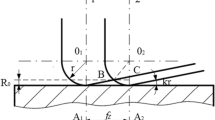Abstract
When machining a free-form surface automatically and digitally, especially in the case of sophisticated surface shapes, it is very difficult to control the surface quality, and thus sophisticated surfaces are usually polished using manual labor. Over the past few years, there has been little attention to the calculation of material removal depth models and construction of theoretical roughness models considering the influence of the curvature radius. Bonnet polishing can be automatically adapted to polish complex free-form surfaces. This paper explores key problems related to forecasting surface quality with respect to bonnet polishing of free-form surfaces. First, for the convex and planar sub-regions, this paper deduces the relationship expressing the maximum pressure distribution and the curvature radius, and presents a computational expression for material removal depth, taking into consideration the influence of the curvature radius. An expression is also deduced for the dwell time relationship between the adjacent processing points according to the experimental results pertaining to the material removal depth. From this, a theoretical roughness model is constructed that relates the bonnet curvature radius and the workpiece curvature radius. The validity of the experiments is summarized in the conclusion. The research findings provide a basic theory for the prediction of surface quality that can be automatically adapted to a free-form surface shape in bonnet polishing.
Similar content being viewed by others
References
Lasemi A, Xue D, Peihua G (2010) Recent development in CNC machining of free form surfaces: a state-of–the art review. Comput Aided Des 42:641–654
Li B, Li F, Liu H, Cai H, Mao X, Peng F (2014) A measurement strategy and an error-compensation model for the on-machine laser measurement of large-scale free-form surfaces. Meas Sci Technol 25(01):11–23
de Souza AF, Machado A, Beckert SF, Diniz AE (2014) Evaluating the roughness according to the tool path strategy when milling free form surfaces for mold application. Procedia CIRP 14:188–193
Hamed K, Lionel B, Souheil-Antoine T (2015) Uniform scanning path generation for abrasive waterjet polishing of free-form surfaces modeled by triangulated meshes. Int J Adv Manuf Technol 77(5–8):1167–1176
Ramos AM, Relvas C, Simoes JA (2003) The influence of finish milling strategies on texture, roughness and dimensional deviation on the machining of complex surfaces. J Mater Process Technol 136:209–216
Lasemi A, Xue D, Peihua G (2014) Tool path re-planning in free-form surface machining for compensation of process-related errors. Int J Prod Res 52(20):5913–5931
Steffen H, Claus R, Lothar G, Lars L (2011) Constant cusp toolpath generation in configuration space based on offset curves. Int J Adv Manuf Technol 53(1–4):325–338
Yang DCH, Chuang JJ, Han Z, Ding S (2006) Boundary-conformed toolpath generation for trimmed free-form surfaces via Coons reparametrization. J Mater Process Technol 138:138–144
Sheng W, Chen H, Xi N, Chen Y (2005) Tool path planning for compound surfaces in spray forming processes. IEEE Trans Autom Sci Eng 2(3):240–249
Djebali S, Segonds S, Redonnet JM, Rubio W (2015) Using the global optimisation methods to minimise the machining path length of the free-form surfaces in the three-axis milling. Int J Prod Res 53(17):5296–5309
SD Jacobs. International innovations in optical finishing. Proc Soc Photo-Opitcal Instrument Eng (SPIE), 2004, 5523: 264–272
Walker DD, Beaucamp ATH, Brooks D, Freeman R, King A, McCavana G, Morten R, Riley D, Simm J (2002) Novel CNC polishing process for control of form and texture on aspheric surfaces. Proc SPIE 4767:99–105
Bingham RG, Walker DD, Kim DH, Brooks D, Freeman R, Riley D (2000) A novel automated process for aspheric surfaces. Proc Soc Photo-Optical Instrument Eng 4093:445–450
Zeng S, Blunt L (2014) An experimental study on the correlation of polishing force and material removal for bonnet polishing of cobalt chrome alloy. Int J Adv Manuf Technol 73(1–4):185–193
Beaucamp A, Namba Y (2013) Super-smooth finishing of diamond turned hard X-ray molding dies by combined fluid jet and bonnet polishing. CIRP Annals-Manufact Technol 62(01):315–318
Beaucamp A, Namba Y, Chariton P (2014) Corrective finishing of extreme ultraviolet photomask blanks by precessed bonnet polisher. Appl Opt 53(14):3075–3080
XIE DG, GAO B, YAO YX, Yuan ZJ (2006) Study of local material removal model of bonnet tool polishing. Key Eng Mater 304–305:335–339
Song J, Yingxue Y, Dagang X, Gao B, Yuan Z (2008) Effects of polishing parameters on material removal for curved optical glasses in bonnet polishing. Chin J Mech Eng 21(5):29–33
Jianfeng S, Yingxue Y (2015) Material removal model considering influence of curvature radius in bonnet polishing convex surface. Chin J Mech Eng 28(6):1109–1116
Pan R, Zhang Y, Ding J, Huang C, Wang Z (2016) Optimization strategy on conformal polishing of precision optics using bonnet tool. Int J Precis Eng Manuf 17(05):271–280
Pan R, Wang Z, Wang C-J, Xie YH, Zhang DX, Guo YB (2014) Research on control optimization for bonnet polishing system. Int J Precis Eng Manuf 15(03):483–488
Wang C, Yang W, Wang Z, Yang X, Hu C, Zhong B, Guo Y, Xu Q (2014) Dwell-time algorithm for polishing large optics. Appl Opt 53(21):4752–4760
Kim DW, Kim SW (2005) Novel simulation technique for efficient fabrication of 2m class hexagonal segments for extremely large telescope primary mirrors. Proc Soc Photo-Opitcal Instrument Eng 5638:48–59
Kim DW, Kim SW (2005) Static tool influence function for fabrication simulation of hexagonal mirror segments for extremely large telescopes. Opt Express 13:910–917
Johnson KL (1985) Contact mechanics. Cambridge University Press, Cambridge
Preston FW (1927) The theory and design of plate glass polishing. J Soc Glas Technol 11:214–256
Author information
Authors and Affiliations
Corresponding author
Additional information
Supported by Young Teacher Independent Research Subject of Yanshan University of China (Grant No. 15LGA002).
Supported by the Chinese government scholarship for studying aboard as a visiting scholar (File No.201708130004).
Rights and permissions
About this article
Cite this article
Song, J., Yao, Y., Dong, Y. et al. Prediction of surface quality considering the influence of the curvature radius for polishing of a free-form surface based on local shapes. Int J Adv Manuf Technol 95, 11–25 (2018). https://doi.org/10.1007/s00170-017-0934-5
Received:
Accepted:
Published:
Issue Date:
DOI: https://doi.org/10.1007/s00170-017-0934-5




